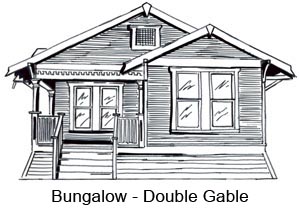




Woodland Heights
Architectural Styles
Most of the buildings in Woodland Heights are one-story and two-story houses. The neighborhood also contains a few duplexes and four-plex apartment buildings. The most common type of house is a wood-framed bungalow. A bungalow is a one-story house with a low-pitched roof and wide eaves, and a large front porch. The bungalow was one of the most common house forms in Houston’s suburban neighborhoods between 1905 and 1925. Some bungalows have Craftsman details.
Historic houses can be identified by both form (shape) and architectural style. Sometimes the style dictates the form of the house. In other cases, specific stylistic details are applied to a more generic house form. Both form and style help to identify when a house was built. Architectural styles have gone in and out of fashion over time.
Woodland Heights was established around the turn of the 20th century. The most popular architectural styles of the 19th century were becoming outdated. New styles were taking their place. Buildings in Woodland Heights reflect that transition.
The “Victorian Era” lasted from 1837 to 1901. Many Victorian-era buildings were decorated with elaborate details. They were designed to imitate the architecture of Gothic cathedrals. In America, this was called the Queen Anne style. Queen Anne houses could be one or two stories tall. They were relatively large and had irregular shapes and high-pitched roofs. Queen Anne details included intricate spindlework on the porch, and textured shingles or siding.
As the popularity of Victorian-era waned, the Arts and Crafts Movement became popular in the early 1900s. Arts and Crafts was a shift from intricate decoration to order and restraint in the decorative arts. Two new building styles developed during this period. The Craftsman style was developed in California by Greene and Greene, a pair of architects who were brothers. Craftsman bungalows had low-pitched roofs with wide eaves. The Prairie style was developed in Chicago by architect Frank Lloyd Wright. Houses in both styles had low-pitched roofs with wide eaves. Decorations were still prominent, but they were much more simplified. Between 1900 and 1930, these were the most popular architectural styles in America.